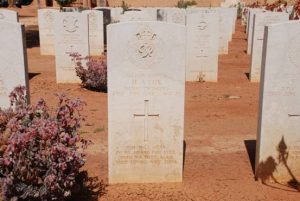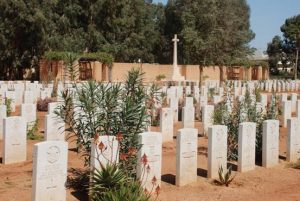Sapper Henry Arthur Cox
Personal Details
- 1922655 Sapper
- Henry Arthur Cox
- 28 Bomb Disposal Company
- Royal Engineers
Benghazi War Cemetery
Benghazi was an important goal for both the Allies and Axis forces during the Western Desert campaigns of 1942 and 1943. There are now 1,214 Commonwealth servicemen of the Second World War buried or commemorated in Benghazi War Cemetery. 163 of the burials are unidentified. Special memorials commemorate two casualties buried in Barce War Cemetery, whose graves could not be located.
2 Comments
Leave a Reply to gary Cancel reply

About Us
The aim of the site is to provide a meeting point for all those involved in Explosive Ordnance Disposal (EOD) or Search whether serving or ex-serving members of the Royal Engineers and a source of material for those researching the work of the Royal Engineers or family history
Links
Donate
If you wish to donate to the running of the branch, please use the button below.
Terms & Conditions | Privacy Policy | Copyright © 2023 The Royal Engineers Association.
All rights reserved.




Harry Cox was born in London and grew up in Hythe, Kent. He was over 6 feet 3 inches, and called Little Harry to differentiate from his father, Big Harry, who was 6 feet 4 inches. He was apprenticed to a cabinet maker and became qualified. A keen cyclist, he won medals with the Cinque Ports cycling club before the war. He played the piano and clarinet with a small dance band. When the war started he volunteered, hoping his skills would lead him to being a “Chippie” in the Royal Navy. In fact he was drafted into the Royal Engineers.
After fighting in France, he came back from Dunkirk wearing only the botton half of his pyjamas, having been evacuated from a field hospital. After leave he returned to his unit and was sent to a Bomb Disposal Unit. He worked in London all through the Blitz, and eventually was offered a Commission, which he delcined. It would mean moving from the close-knit unit, who all knew and trusted each other. Their lives literally depended on each other.
He married Edna shortly before being posted to Egypt. Edna was barely five feet, and wore a tall, orange-blossom tiara to try and “bridge the gap” in their heights. There were no children.
In the desert, the unit was set to clearing mines. They hated this; bombs they knew; mines were more unpredcitable. They were right. Their lorry went over a mine and was blown up.
Harry wrote regularly and receiving no letters created anxiety at home, but people said, in the manner of the time, “No news is good news”. It wasn’t — in the Autumn the dreaded orange envelope arrived. In due course it was noticed that Sapper Cox’s name was not on any war memorial. With the help of the Royal British Legion, this oversight was corrected and he is now recorded on the Hythe memorial on the Royal Military Canal bank.
In my possession is a small snapshot of the ‘gang’ in their lorry, taken shortly before what is called “the incident”. This might be of interest someone related to those concerned.
Thank you for this insight. Please forward the snapshot and happy to add it to our archive. Kind Regards, Gary